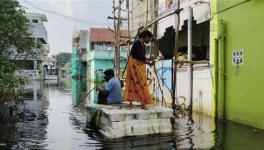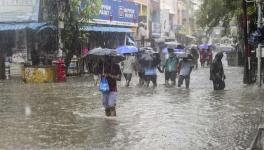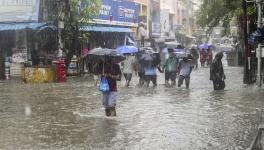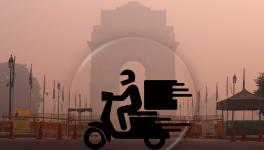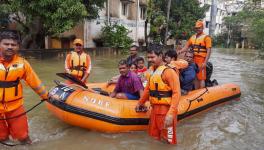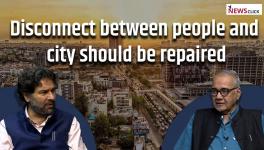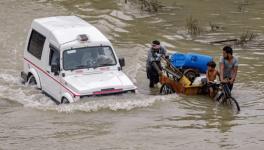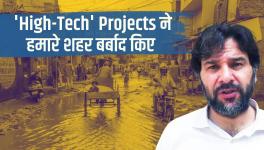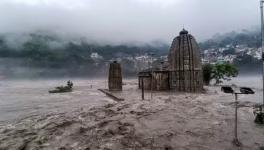Unscientific Urban Expansion, Land Use, Faulty Stormwater Drains Flooding Chennai
Tractors and pumps deployed to pump out water from a street in Kodambakkam.
The mission statement of the smart cities solution claims 'to promote cities that provide core infrastructure, clean and sustainable environment and give a decent quality of life to their citizens through the application of smart solutions’. But in Chennai, one of the first cities where the project was implemented in Tamil Nadu in 2015, the water inundation problem has only worsened.
An already flawed town planning, unscientific urban land use, drainage system and hasty implementation of smart city works have only magnified the problems of water inundation in Chennai.
In November, during the northeast monsoon (NEM), the city faced water inundation on multiple occasions, bringing life to a standstill. Despite different schemes implemented by the state government and the Greater Chennai Corporation (GCC), the deployment of motor pumps in several parts of the city to drain water from the streets and roads are the only successful mechanisms existing so far.
The Singara Chennai (Beautiful Chennai) project of the state government also seems to make cosmetic interventions and not concentrate on finding solutions for the deeper and structural problems leading to floods in the city.
UNSCIENTIFIC URBAN EXPANSION
Chennai is located on the Coromandel coast along the eastern coastal plains. The city is relatively flat and close to the sea level; it once had a natural drainage system saving the city from floods and water inundation. Thanks to the rapid urbanisation, the city has lost the system leading to the current mess.
S Janakarajan, a former professor at the Madras Institute of Development Studies (MIDS), accused the poor development planning of the city as the primary reason for the repetitive incidents of water inundation.
“Chennai once had 16 major drains, 35 micro drains and hundreds of other drains to disseminate rain water. The unplanned land use and rapid urbanisation combined with the mess in the drainage system have led to the water inundation problems”, he said.
Image: Topography of Chennai (Courtesy: Raj Bhagat)
The unscientific urban land use, expansion and development policy has contributed largely to the prevailing situation. The Chennai Master Plan (CMP) 2001 and CMP 2011 prepared by the Chennai Metropolitan Development Authority (CMDA) have failed to consider any scientific considerations, while the CMP 2026 is also allegedly falls in the same line.
Raj Bhagat, senior program manager with WRI India Geoanalytics spoke about the encroachment of the water bodies in the city and its surroundings. “The shallow and large water bodies were plenty in numbers due to the agricultural activities in the region. The expansion of the city in these parts, where water flowed freely are now residential, commercial or other built up areas,” he said.
Expansion of the city in the southern part, which is low lying and has wetlands including Pallikaranai. (Courtesy: Raj Bhagat)
“The area of the Chennai city was 174 sq km a decade back and has expanded to 426 sq km now. The metropolitan area is expected to increase to 8,800 sq km from the existing 1,190 sq km. With such rapid expansion and the absence of political will and commitment, a solution is close to impossible”, Janakarajan said.
HOW SCIENTIFIC ARE DRAINAGES?
The loss of natural drains and urbanisation call for a scientific drainage system to keep the city free from flooding and water inundation. However, since the massive floods in 2005 and 2015, the governments and the civic bodies have failed miserably in moving towards finding solutions.
Raj Bhagat, Senior program manager with WRI India Geoanalytics, ridiculed the unscientific approach towards the construction of the stormwater drainages. “The stormwater drains are almost absent in most parts of the city. The rainfall rate required for the design of the drains has not been considered. The sizes of the drains remain uniform all through, which should not be the case to carry the water,” he said.
The expansion of the GCC, by merging other local bodies, including municipalities and village panchayats, has added to the misery of water inundation.
“The city has been growing in the low-lying areas which once had water bodies and farmlands. When such areas are merged with the GCC, the water inundation problems escalate. The CMA or the disaster management plans have not considered such hindrances while planning for the expansion,” Bhagat said.
The unavailability of the plans for the stormwater drains in areas like T Nagar, where the smart city projects are implemented, exposes the lack of transparency in the civic body administration. The region was safe from water inundation during the 2015 floods, but suffered from inundation multiple times in 2021.
Image Courtesy: Raj Bhagat
“Outlet is at 5.7+ m and whereas the places where they are flowing from drain bottoms are located at <5m. Two feet difference is there already. How will water flow in this drain?” Bhagat asked.
Prof Janakarajan also questioned the design investing several hundreds of crores for a small region again and again, while the solution remains elusive. “With an effective drainage system, the present rainfall of 200mm to 250mm per day should be easily drainable and should not cause any inundation. But, the existing system is so pathetic,” he said.
SMART CITY AND SINGARA CHENNAI
The projects, smart city and singara chennai of the Union and state governments respectively have failed to live up to the promises. M K Stalin, the present chief minister, during his tenure as the Chennai Mayor, inaugurated the Singara Chennai project.
But Prof Janakarajan finds little or no difference between the much hyped-projects and termed them as more of a beautification process. “Through these projects, parts of Chennai are beautified, made green and areas allocated for pedestrians and cyclists. But such activities will not find solutions for the inherited flooding problems of Chennai,” he said.
He also questioned the scientific approach behind such projects and questioned whether the threat of climate change is considered in them. “The present decade is very crucial for Chennai considering the mean sea level rise. Are we addressing such a threat through these projects?” he asked.
Bhagat said that a solution for the pertaining issues is not possible for the next ten years. "The current government has to redesign and reconstruct the entire city infrastructure. I wonder where they would get the money and time to do this massive restructuring," he said.
Get the latest reports & analysis with people's perspective on Protests, movements & deep analytical videos, discussions of the current affairs in your Telegram app. Subscribe to NewsClick's Telegram channel & get Real-Time updates on stories, as they get published on our website.









